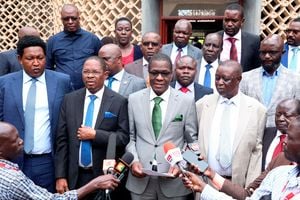Food crisis feared as El Nino rains delayed

What you need to know:
- Met experts insist heavy downpours could still come but add: don’t count on it
Kenya could face an unprecedented food crisis next year, even higher costs of electricity and worse shortages of water because of poor rains.
The current short rains, widely expected to produce el Niño-type weather not only failed to do so; they are even below the normal seasonal amount.
Already, farmers in some parts of the Rift Valley have started to complain of a failing crop and livestock are still dying in pastoral areas because of lack of pasture as the heavens are yet to open up.
The most recent metrological report shows the short rains season has already passed its peak, usually in November. The weathermen also forecast the rains could start reducing any time from next week in some parts of the country.
Highly variable
Assessing the rainfall performance in the last quarter of the year, the weathermen say the rains have been poor and highly variable in many parts. In some areas, they have been below 65 per cent of what is considered normal for the season.
“The poor performance was reflected both in the amounts received and the distribution in time and space especially during the peak rainfall month of November,” says the department.
Just like most farmers, the weathermen are disappointed with the November rains. “The rainfall performance in November was poor and erratic over most parts, with a two-week unprecedented dry spell engulfing most parts of the country.”
However the possibility of an el Niño hitting the country has not been entirely ruled out. “The El Niño phenomenon is still on, but farmers should not bank on it,” says the Central provincial director of meteorology, Mr Francis Nguata.
Although experts expect some parts like western Kenya to continue receiving rainfall well into January, most parts of the country, including the North Rift, Eastern and Coast provinces, may start to see a drying up in the next few weeks.
In the North Rift, farmers say they face the prospect of losing a second crop within a year as plants start to dry up in what looks like the end of the rains.
“The erratic rains have resulted in poor crop germination and most of which have started to wither due to poor rains,” said Mr Isaac Kibogy, who invested over Sh300,000 to plant a second wheat crop.
A second crop
The government allocated Sh1 billion in September to provide farm inputs to farmers who were asked to take advantage of predicted el Niño rains to plant a second crop but the rains have not been dependable.
“Hunger remains inevitable unless the government swiftly moves in to address the situation by importing maize and motivating farmers to invest in drought resistant crops,” says Mary Chepkemboi, a farmer in from Keiyo District.
But it is the pastoral areas which are most hit with some like Narok receiving a negligible amount of rainfall. In Kajiado, where most herders lost three-quarters of their animals, the regenerated pasture is hardly enough to support the remaining stock.
“There isn’t enough pasture for our cattle,” says retired chief Jeremiah Tompesi of Enkaloni in Kajiado. “Cattle here are still weak and the grass still insufficient to sustain the few remaining.”
Search for pasture
According to Hesbon Sapur, a social worker in this area, most people have just trooped back after escaping the ravaging drought to search for pasture and water for their livestock elsewhere.
Most herders in the area moved to Tanzania while others headed to the Nairobi National Park and Central Kenya. “We thought that the rains would be heavy and last long enough so we came back only to be disappointed,” says Sapur.
He is already considering returning his remaining 23 cows, from an initial herd of 126, back to Nairobi.
The rains have not been enough to fill various hydroelectric and water supply dams in the country. According to the communications manager at the Nairobi Water Company, Mr Mbaruku Vyakweli, Ndakaini dam, which is the main supplier of water to Nairobi, is still a long way from getting to normal levels of water.
By last week, he said, the dam had only 57 per cent of its holding capacity.
Talking to our sister publication, the Business Daily, Dr James Nyoro, a food policy expert and regional managing director of Rockefeller Foundation, said the failure of the short rains will cause maize production deficit of up to 16 million bags by next year.
In Turkana, Pokot and Samburu areas, the failure of the short rains is reflected in the increasing number of cholera cases reported so far as humans, livestock and wildlife scramble over already stressed water points.
The Famine Early Warning Network predicts more conflict among these pastoralist communities which could further decimate livestock.
On Monday, the authorities said they were on alert to deal with the consequences in case the rains fail.
The Director of Public Health Dr Shanaaz Shariff told the Nation: “We want to ensure that more boreholes are dug in several places while water tankers will be mobilised to supply the commodity to those who might require water.”
The projects will co-ordinate in conjunction with the Water and Irrigation Development Ministry.
He said public hospitals and dispensaries had been supplied with chlorine and other medical supplies to enable health workers respond to disease outbreaks should the rains fail.
The Nairobi Water Company said the water already in the dams will last until the end of January and that it was prepared to deal with shortages.
“The rationing programme will go on whether the dams are full or not, but we have saved enough water to last Nairobi residents up to January without the company having to reduce the days we supply residents with water each week,” Mr Vyakweli said.
Decreased supply
“After January, we may have to adjust our rationing schedule by reducing the number of days we supply residents with water. This is to enable us cope with the decreased supply but the water available can still take us to April next year”.
The company needs 650,000 cubic meters of water each day, but can only supply 525,000 even though the Ndakaini dam is 58 per cent full.
“We have been working with the ministry of Water and the Athi Water Services and have managed to sink 35 boreholes out of the 50 which we had projected, but this is just a drop in the ocean,” he added.
Mr Mike Njeru, the KenGen spokesman, was optimistic that electricity will not be interrupted. Instead, the supply is set to improve following the rise in water levels at the Seven Forks dam, he said.
The levels at Masinga had risen from a low of 1,026 metres to 1,040 metres, significantly below the maximum level of 1,056 metres.
KenGen increasingly relies on diesel-generated electricity, which has seen electricity bills shoot through the roof.
Erratic rains
The deputy director of Meteorological services, Mr Peter Ambenje, has blamed the warming of the Indian Ocean for the erratic rains.
He said Western, Rift Valley and North Eastern were some of the areas where rains have been poor.
“Despite this shortfall, we expect enhanced rainfall in Nairobi, Central, Western and parts of Northeastern this month,” he said.
Reported by Gatonye Gathura, Barnabas Bii, Muchiri Karanja, Simon Siele, Alex Ndirangu, Peter Leftie and Mike Mwaniki




